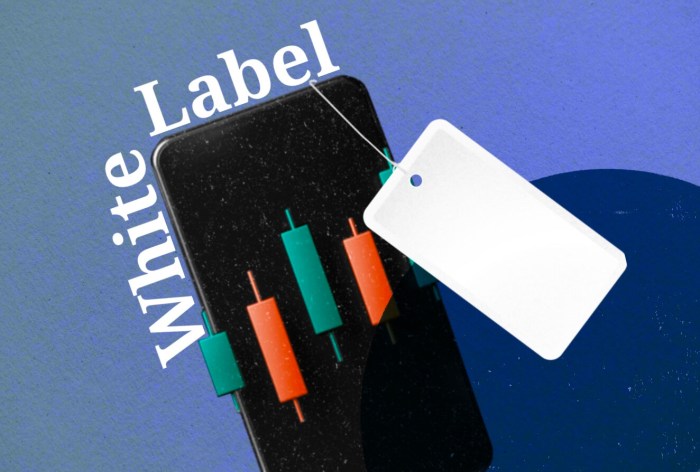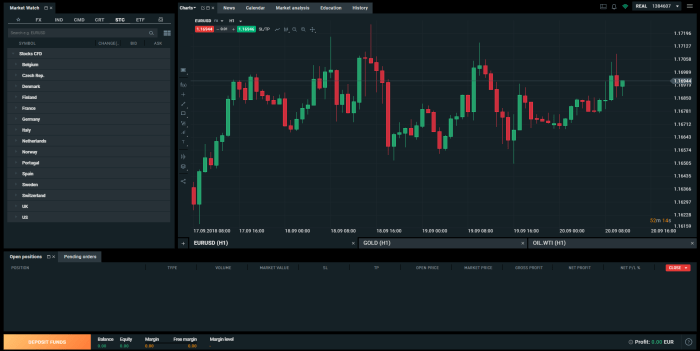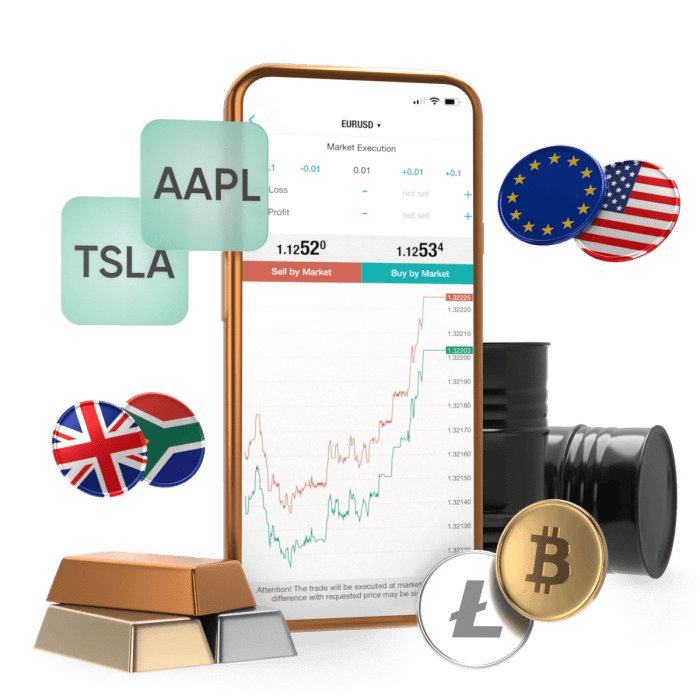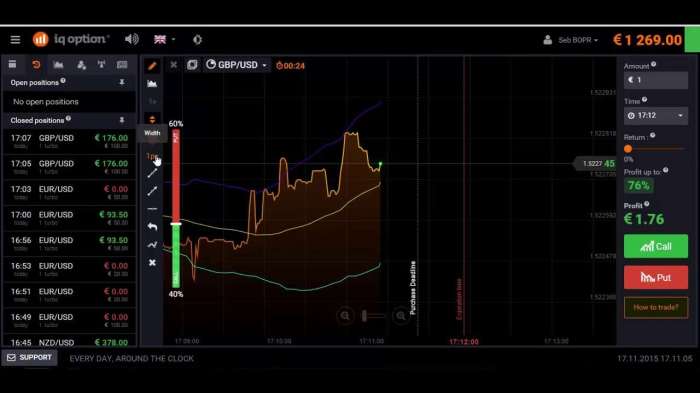
White label forex trading platform – sounds complicated, right? Wrong! Think of it as grabbing a pre-built, fully-functional online forex trading business, ready to slap your brand on and start making money. This isn’t about building from scratch; it’s about leveraging existing tech and expertise to get a head start in the lucrative forex market. We’re diving deep into everything you need to know to launch your own white-label empire, from choosing the right platform to navigating the regulatory landscape.
This guide unpacks the intricacies of white label forex trading platforms, covering market analysis, feature comparisons, client acquisition strategies, pricing models, risk management, and legal compliance. We’ll explore various platforms, highlighting key differences and helping you make informed decisions. Get ready to trade your way to success!
Market Overview of White Label Forex Trading Platforms
The white label forex trading platform market is a dynamic and rapidly evolving sector, fueled by the increasing popularity of online trading and the demand for customized solutions. This market offers brokers and financial institutions a streamlined path to entering the forex market, bypassing the complexities and costs associated with developing their own platforms from scratch. Understanding the current market landscape, key players, and prevalent business models is crucial for anyone considering entering or navigating this competitive space.
The global market for white label forex trading platforms is substantial and shows significant growth potential. While precise figures are difficult to obtain due to the fragmented nature of the industry and the private nature of many businesses, market research suggests a steady increase in market size year-on-year, driven primarily by the rising number of retail forex traders globally and the ongoing technological advancements in the fintech sector. This growth is expected to continue, particularly in emerging markets where internet penetration and financial literacy are on the rise.
Key Players and Market Share
Determining precise market share for individual white label forex platform providers is challenging due to the lack of publicly available data. However, several prominent companies consistently emerge as leaders in the industry. These companies often differentiate themselves through advanced features, robust security measures, and strong customer support. Their success stems from providing comprehensive solutions that cater to the specific needs of their clients, ranging from small brokerage firms to large multinational institutions. The competitive landscape is marked by both established players and emerging startups, creating a dynamic and innovative environment.
Competitive Landscape: Strengths and Weaknesses
The competitive landscape of the white label forex trading platform market is characterized by a diverse range of providers, each with its own strengths and weaknesses. Established players often benefit from a strong brand reputation, extensive client networks, and a proven track record. However, they may sometimes struggle to adapt quickly to emerging technological trends or offer highly customized solutions. Conversely, newer entrants might offer innovative features and more flexible pricing models, but may lack the experience and brand recognition of established companies. A key differentiator is the level of customization offered; some providers focus on providing highly flexible solutions allowing for extensive branding and feature modification, while others offer more standardized packages.
Business Models Employed by White Label Forex Platform Providers
White label forex platform providers typically employ several business models. A common model involves a one-time setup fee and recurring monthly fees based on the number of users or transactions. Some providers also offer tiered pricing structures, with different packages providing varying levels of functionality and support. Other models may include revenue-sharing agreements, where the platform provider receives a percentage of the broker’s profits. The choice of business model depends on several factors, including the provider’s target market, the level of customization offered, and the overall cost structure. For example, a provider focusing on smaller brokers might favor a lower entry fee and higher recurring revenue model, while a provider targeting larger institutions might negotiate more customized, potentially higher-cost solutions.
Features and Functionality of White Label Forex Trading Platforms
So, you’re thinking of launching your own forex brokerage? Smart move! But before you start celebrating imaginary profits, let’s talk about the engine that will drive your success: the white label forex trading platform. Choosing the right one is crucial, and it’s more than just picking a pretty interface. We’re diving deep into the features, functionality, and the tech behind these platforms to ensure you make an informed decision.
Essential Features of a Successful White Label Forex Trading Platform
A robust white label platform isn’t just a pretty face; it’s the backbone of your brokerage. The features listed below are non-negotiable for a truly competitive offering. These features contribute significantly to client satisfaction, operational efficiency, and your bottom line.
| Feature Name | Description | Importance | Competitive Advantage |
|---|---|---|---|
| Advanced Charting & Technical Analysis | Provides clients with a wide array of charting tools, indicators, and drawing tools for technical analysis. | Essential for traders to make informed decisions. | Attracts technically-savvy traders. |
| Multiple Asset Classes | Offers trading in various asset classes beyond just forex, such as stocks, indices, commodities, and cryptocurrencies. | Increases client engagement and trading volume. | Provides a one-stop shop for diverse trading needs. |
| Automated Trading (Expert Advisors/EA) | Allows clients to utilize automated trading strategies through Expert Advisors. | Appeals to sophisticated traders seeking efficiency. | Differentiates the platform by offering advanced trading capabilities. |
| Mobile Trading App | Provides access to trading accounts and functionalities through mobile devices. | Crucial for accessibility and convenience. | Enhances client experience and trading flexibility. |
| Robust Reporting & Analytics | Offers comprehensive reporting tools for both clients and brokers to track performance and analyze trading activity. | Essential for risk management and business decision-making. | Provides valuable insights for improved trading strategies and risk management. |
| Secure Payment Gateway Integration | Facilitates seamless and secure deposits and withdrawals. | Ensures smooth operations and builds client trust. | Reduces friction in the trading process. |
| Customer Support Integration | Provides seamless integration with customer support channels, like live chat or email. | Ensures timely assistance to clients. | Improves client satisfaction and reduces churn. |
| Customizable Branding Options | Allows brokers to personalize the platform with their own branding and logo. | Essential for building brand identity and recognition. | Creates a unique and personalized trading experience. |
Comparison of White Label Forex Trading Platforms
Let’s look at three hypothetical providers – “TradePro,” “ForexMax,” and “GlobalFX” – to illustrate the variety of platforms available. These are examples and do not represent specific real-world providers. Remember to conduct thorough due diligence before selecting a provider.
TradePro boasts a user-friendly interface, prioritizing ease of navigation for beginner traders. Their unique selling proposition (USP) is their integrated educational resources, including webinars and tutorials. ForexMax focuses on advanced charting tools and automated trading, appealing to experienced traders. Their USP is their cutting-edge charting technology and extensive EA support. GlobalFX emphasizes speed and execution, offering ultra-low latency and a wide range of asset classes. Their USP is their lightning-fast trade execution and diverse market offerings.
Technological Infrastructure of White Label Forex Trading Platforms
The technical backbone of a successful white label platform requires a robust infrastructure. This includes high-performance servers capable of handling large volumes of data and transactions with minimal latency. A secure network architecture is critical, along with redundant systems to ensure high availability and prevent downtime. Scalability is key to accommodate future growth and increased user traffic. Efficient database management systems are essential for storing and retrieving vast amounts of trading data. Furthermore, a well-defined API (Application Programming Interface) is needed for seamless integration with other systems, such as payment gateways and CRM software.
Security Features and Regulatory Compliance
Security and regulatory compliance are paramount. Data breaches can severely damage reputation and lead to significant financial losses. Robust security measures, including encryption, firewalls, and intrusion detection systems, are crucial. Compliance with relevant regulations, such as KYC (Know Your Customer) and AML (Anti-Money Laundering) guidelines, is mandatory to operate legally and ethically. Regular security audits and penetration testing should be conducted to identify and address vulnerabilities. Choosing a provider with a strong track record of security and regulatory compliance is vital for your business’s success and longevity.
Client Acquisition and Retention Strategies

Successfully launching a white label forex trading platform hinges not just on a robust platform but also on a well-defined strategy for attracting and retaining clients. This involves a multi-pronged approach encompassing targeted marketing, seamless onboarding, and consistent engagement to foster loyalty. Ignoring these crucial aspects can lead to a stagnant platform, regardless of its technological prowess.
A comprehensive marketing plan is the cornerstone of client acquisition. It’s about reaching the right audience with the right message at the right time. This necessitates a deep understanding of your target demographic, their trading styles, and their preferred communication channels. Furthermore, a strong brand identity is essential to differentiate your platform in a crowded market.
Marketing Plan for Client Acquisition
A successful marketing strategy needs a blend of digital and potentially offline channels. Focusing solely on one approach often limits reach and impact. A diversified strategy allows for testing and optimization, leading to higher ROI.
- Search Engine Optimization (): Invest in to improve organic search rankings for relevant s. This involves optimizing website content, building high-quality backlinks, and ensuring a user-friendly website experience. Think long-tail s like “low-spread forex trading platform” or “ECN forex broker for beginners”.
- Pay-Per-Click (PPC) Advertising: Utilize platforms like Google Ads and social media advertising to target specific demographics with tailored ads. A/B testing different ad creatives and targeting parameters is crucial to maximizing efficiency.
- Social Media Marketing: Engage with potential clients on platforms like Facebook, Instagram, and Twitter. Share educational content, market insights, and success stories to build trust and credibility. Consider influencer marketing to leverage the reach of established figures in the forex trading community.
- Content Marketing: Create high-quality, informative content such as blog posts, articles, webinars, and e-books to attract and educate potential clients. This establishes you as a thought leader and drives organic traffic to your website.
- Affiliate Marketing: Partner with relevant websites and influencers to promote your platform in exchange for a commission on each successful referral. This can be a cost-effective way to reach a wider audience.
Effective Client Onboarding Processes
A smooth and efficient onboarding process is crucial for setting the stage for a positive client experience. It should be designed to minimize friction and quickly get new traders up and running.
Find out about how trading futures vs forex can deliver the best answers for your issues.
- Simplified Account Opening: Make the account opening process as straightforward as possible, minimizing the number of required fields and offering multiple verification options.
- Interactive Tutorials and Educational Resources: Provide easy-to-understand tutorials and educational materials to help new clients familiarize themselves with the platform’s features and functionalities. This could include video guides, FAQs, and interactive demos.
- Dedicated Account Manager Support: Assign each new client a dedicated account manager to provide personalized support and guidance during the initial stages. This fosters a sense of trust and personal attention.
- Welcome Package and Ongoing Communication: Send a welcome email with essential information and links to helpful resources. Maintain regular communication through newsletters, updates, and personalized messages to keep clients engaged.
Strategies for Enhancing Client Retention and Building Loyalty
Retention is as important, if not more so, than acquisition. It’s far cheaper to retain existing clients than to acquire new ones. Loyalty programs and personalized engagement are key to long-term success.
- Loyalty Programs and Rewards: Implement a loyalty program that rewards clients for their continued engagement and trading volume. This could include cashback offers, exclusive trading tools, or invitations to VIP events.
- Personalized Communication and Support: Provide personalized support and communication based on individual client needs and trading styles. This demonstrates that you value their business and are committed to their success.
- Regular Feedback and Improvement: Solicit regular feedback from clients to identify areas for improvement and enhance their overall experience. This shows that you are actively listening and striving to meet their needs.
- Educational Webinars and Workshops: Host regular webinars and workshops to provide clients with valuable trading insights and education. This keeps them engaged and helps them improve their trading skills.
- Community Building: Foster a sense of community among your clients by creating a forum or social media group where they can connect and share their experiences. This creates a sense of belonging and encourages loyalty.
Comparison of CRM Systems for White Label Forex Brokers
Choosing the right CRM is crucial for managing client relationships effectively. Different systems offer varying features and functionalities, so selecting the best fit depends on your specific needs and budget.
Obtain a comprehensive document about the application of forex trading mentor that is effective.
| CRM System | Key Features | Pros | Cons |
|---|---|---|---|
| Salesforce | Comprehensive suite of tools for sales, marketing, and customer service; highly customizable | Powerful features, scalability, extensive integrations | Can be expensive, complex to implement and manage |
| HubSpot | Strong focus on inbound marketing and sales automation; free and paid plans available | User-friendly interface, cost-effective options, good for smaller businesses | Limited features compared to Salesforce, may require add-ons for advanced functionality |
| Zoho CRM | Affordable and feature-rich CRM with a wide range of integrations; good for small and medium-sized businesses | Cost-effective, user-friendly, good range of features | May not be as scalable as Salesforce or HubSpot for very large businesses |
Pricing and Revenue Models for White Label Forex Platforms
Navigating the world of white label forex platforms requires a keen understanding of how these businesses operate financially. Profitability hinges on a smart pricing strategy and diverse revenue streams, making this a crucial aspect for both platform providers and brokers. Let’s delve into the nitty-gritty of how these platforms generate income.
Pricing Models for White Label Forex Platform Providers
White label forex platform providers typically employ a range of pricing models, each tailored to different client needs and scales of operation. These models often combine fixed fees with performance-based incentives, creating a dynamic revenue structure. The specific pricing structure depends heavily on the features offered, the level of support provided, and the volume of trading expected.
Revenue Streams for White Label Forex Brokers
White label forex brokers can tap into multiple revenue streams to maximize their profitability. This isn’t just about the platform fee; it’s about leveraging the entire trading ecosystem.
- Spreads: The most common revenue source, spreads represent the difference between the bid and ask price of a currency pair. Brokers profit from the difference.
- Commissions: Some brokers charge a commission per trade executed, either in addition to or instead of spreads. This is particularly common with higher-volume traders.
- Swap Fees: Overnight financing charges (swap fees) are applied to positions held open past a certain time. These fees can be a significant revenue stream, especially for longer-term trades.
- Account Management Fees: Some brokers offer managed account services, charging a percentage of the managed assets under their control.
- Affiliate Programs: Many brokers generate revenue through affiliate programs, paying commissions to individuals or businesses who refer new clients.
- Educational Products and Services: Offering courses, webinars, or other educational resources can create an additional revenue stream, increasing client engagement and potentially leading to more trading activity.
Hypothetical Financial Model: Profitability Under Different Market Conditions
Let’s imagine a hypothetical white label forex broker, “GlobalFX,” using a monthly subscription model of $500 for the platform and earning primarily from spreads (averaging $2 per trade).
| Market Condition | Average Daily Trades | Spread Revenue (Monthly) | Platform Costs | Net Profit (Monthly) |
|---|---|---|---|---|
| High Volatility | 500 | $3000 | $500 | $2500 |
| Moderate Volatility | 250 | $1500 | $500 | $1000 |
| Low Volatility | 100 | $600 | $500 | $100 |
This simplified model demonstrates how profitability is directly tied to market activity. High volatility translates to more trading and higher revenue, while low volatility can lead to lower profits or even losses if costs are not managed effectively. Note that this model ignores other potential revenue streams and expenses.
Comparison of Revenue Models: Two Hypothetical Providers
Let’s compare two hypothetical white label providers: “Platform A” and “Platform B.”
- Platform A: Uses a tiered pricing model based on trading volume. Lower volume traders pay a fixed monthly fee, while higher volume traders pay a lower per-trade fee. Revenue is primarily generated through platform fees and a small percentage of spreads.
- Platform B: Offers a flat monthly fee with unlimited trading volume. Revenue is generated primarily through a larger percentage of spreads and commissions, supplemented by affiliate programs and educational offerings.
Platform A’s model is suitable for brokers focusing on attracting a large number of smaller traders, while Platform B is more attractive to brokers targeting high-volume traders or those seeking to diversify their revenue streams. The optimal choice depends entirely on the broker’s business strategy and target market.
Risks and Challenges in the White Label Forex Trading Platform Business
The white label forex trading platform business, while offering significant potential for profit, is fraught with inherent risks and regulatory hurdles. Navigating this landscape requires a deep understanding of these challenges and a proactive approach to risk mitigation. Failure to do so can lead to substantial financial losses, reputational damage, and even legal repercussions.
Key Risks Associated with Operating a White Label Forex Trading Platform
Operating a white label forex platform exposes businesses to a variety of risks. These risks span operational inefficiencies, financial instability, and reputational damage. Understanding these potential pitfalls is crucial for developing effective risk management strategies. For instance, a sudden downturn in the forex market could severely impact the profitability of the platform, while a security breach could lead to significant financial losses and damage to customer trust. Similarly, relying on a poorly performing or unreliable white label provider can lead to operational disruptions and loss of revenue. Choosing a reputable and financially stable provider is paramount to mitigating this risk.
Regulatory Challenges Faced by White Label Forex Brokers
The regulatory landscape for forex trading is complex and varies significantly across jurisdictions. White label brokers must navigate a maze of licensing requirements, reporting obligations, and compliance standards. Failure to comply with these regulations can result in hefty fines, operational restrictions, and even the closure of the business. For example, obtaining the necessary licenses in regions like the UK (FCA), Australia (ASIC), or the US (CFTC and NFA) involves a rigorous process and ongoing compliance obligations. Understanding and adhering to the specific regulatory requirements of each target market is essential for long-term success. Ignoring these requirements could expose the business to severe penalties and irreparable reputational damage.
Strategies for Mitigating Fraud and Money Laundering Risks
The forex market is unfortunately susceptible to fraudulent activities and money laundering schemes. White label forex brokers must implement robust measures to prevent and detect such activities. These measures should include thorough Know Your Customer (KYC) and Anti-Money Laundering (AML) procedures, regular audits of transactions, and collaboration with financial intelligence units. For example, implementing a multi-layered KYC process that verifies client identities through multiple sources significantly reduces the risk of accepting fraudulent accounts. Similarly, employing advanced transaction monitoring systems can help identify suspicious patterns and flag potentially illicit activities. Failing to adequately address these risks could lead to significant financial losses, legal penalties, and severe damage to the platform’s reputation.
Risk Management Plan for a White Label Forex Trading Platform
A comprehensive risk management plan is essential for any white label forex trading platform. This plan should encompass various aspects of the business, including operational, financial, regulatory, and reputational risks. The plan should Artikel specific procedures for identifying, assessing, mitigating, and monitoring risks. For instance, regular security audits, robust data backup and recovery systems, and comprehensive insurance coverage are crucial components of a strong risk management framework. Moreover, the plan should include clear escalation procedures for handling identified risks and a mechanism for regularly reviewing and updating the plan to reflect changes in the market and regulatory environment. A well-defined risk management plan acts as a safety net, protecting the business from unforeseen circumstances and ensuring its long-term viability. It’s not just about preventing problems; it’s about preparing for them, responding effectively, and learning from any mistakes made.
Technological Aspects and Integration
Choosing the right technology is crucial for a successful white label forex trading platform. The platform’s performance directly impacts your clients’ trading experience and, ultimately, your business’s success. A robust, reliable, and scalable platform is paramount, and understanding the technical intricacies is key to making informed decisions.
The technological backbone of your white-label forex platform involves several key aspects, from the core trading platform itself to its integration with crucial third-party services. Let’s delve into the specifics.
Trading Platform Selection
The choice of trading platform significantly influences user experience and functionality. Popular options include MetaTrader 4 (MT4), MetaTrader 5 (MT5), and cTrader. MT4 remains a widely used platform known for its simplicity and extensive customization options, while MT5 offers advanced features like algorithmic trading and a broader range of order types. cTrader, on the other hand, is praised for its speed and user-friendly interface, particularly appealing to more technologically savvy traders. Each platform caters to different preferences and needs, requiring careful consideration of your target clientele.
Payment Gateway Integration
Seamless payment processing is critical for a smooth trading experience. Integrating your white label platform with reputable payment gateways is essential for handling deposits and withdrawals efficiently and securely. Popular options include various payment processors that offer services tailored to the financial industry, ensuring compliance with regulations and providing secure transaction processing. The integration process typically involves API keys and secure communication protocols to ensure the safe transfer of financial information. This integration needs to be carefully planned and tested to avoid any disruption to trading activities. A failure in this area can severely impact client trust and operational efficiency.
API Integrations and Expanded Functionality
Application Programming Interfaces (APIs) are the unsung heroes of platform expansion. They allow your white-label platform to connect with other systems, expanding functionality and creating a more comprehensive trading ecosystem. For example, APIs can integrate market data feeds from various providers, connect to CRM systems for client management, or link to social media platforms for marketing purposes. A well-designed API strategy allows for flexible integration with a variety of tools and services, making your platform more adaptable and responsive to evolving market needs. Consider the potential for integrating automated trading tools, risk management systems, and even educational resources through strategic API partnerships.
Essential Technical Specifications for High-Performance Platforms
A high-performing white label forex platform requires careful attention to technical specifications. These specifications directly influence the platform’s stability, speed, and security.
- Scalability: The platform must handle a growing number of users and transactions without performance degradation.
- Security: Robust security measures, including encryption and fraud detection systems, are crucial to protect client funds and data.
- Reliability: High uptime and minimal downtime are essential for maintaining client trust and ensuring uninterrupted trading.
- Speed: Fast execution speeds are critical for traders, especially in fast-paced markets.
- Customization: The ability to customize the platform’s branding and features to match your specific needs is vital.
- Compliance: The platform must comply with all relevant financial regulations and licensing requirements.
- Reporting and Analytics: Comprehensive reporting tools are necessary for monitoring platform performance and making data-driven decisions.
Legal and Regulatory Compliance

Navigating the legal landscape of white label forex trading platforms is crucial for success and avoiding hefty fines or even business closure. This section Artikels key legal and regulatory considerations across various jurisdictions, emphasizing the importance of compliance for a sustainable and reputable business. Ignoring these aspects can lead to significant financial and reputational damage.
Operating a white label forex trading platform demands meticulous attention to a complex web of regulations that vary significantly depending on your target market and the location of your business operations. Failure to comply with these regulations can lead to severe consequences, including hefty fines, license revocation, and even criminal prosecution. Understanding and adhering to these rules is not just a legal obligation; it’s a cornerstone of building trust with clients and maintaining a sustainable business.
Licensing and Permits
Securing the necessary licenses and permits is paramount. The specific requirements differ greatly based on geographical location. For instance, operating within the European Union necessitates adherence to the Markets in Financial Instruments Directive (MiFID II), demanding authorization from a relevant regulatory body. Similarly, in the United States, registration with the Commodity Futures Trading Commission (CFTC) and compliance with the National Futures Association (NFA) regulations are essential. Failing to obtain these crucial licenses can result in significant penalties and operational restrictions. Before launching, thorough research into the specific legal framework of your chosen jurisdictions is mandatory. Engaging legal counsel specializing in financial regulations is highly recommended.
Anti-Money Laundering (AML) and Know Your Customer (KYC) Regulations, White label forex trading platform
AML and KYC regulations are designed to prevent the use of forex trading platforms for illicit activities such as money laundering and terrorist financing. These regulations mandate robust customer due diligence processes, including verifying client identities, monitoring transactions for suspicious activity, and reporting any potentially illegal activities to the appropriate authorities. The consequences of non-compliance are severe, ranging from substantial fines to the freezing of assets and even criminal charges. Implementing a comprehensive AML/KYC program is not merely a compliance requirement; it is a vital step in maintaining the integrity of your platform and protecting your business from reputational damage. This often involves implementing sophisticated transaction monitoring systems and employing trained compliance officers.
Consequences of Non-Compliance
Non-compliance with forex trading regulations can lead to a range of severe consequences. These can include substantial financial penalties imposed by regulatory bodies, legal action from affected clients, reputational damage that can harm your business’s credibility and attract negative media attention, and operational restrictions, such as limitations on activities or even a complete shutdown of the platform. In some cases, severe non-compliance can result in criminal charges against individuals involved in the operation of the platform. The specific penalties vary depending on the jurisdiction and the severity of the violation. A proactive approach to compliance is crucial for minimizing these risks and ensuring the long-term success of your white label forex trading platform.
Summary
Launching a white label forex trading platform offers a compelling path to success in the financial markets, but it demands careful planning and execution. By understanding the market dynamics, choosing the right platform, implementing effective marketing strategies, and adhering to regulatory requirements, you can build a thriving business. Remember, thorough due diligence and a robust risk management plan are essential for long-term sustainability. So, are you ready to take the plunge?




